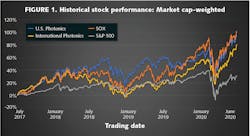New photonics stock indices: A spotlight on the ecosystem of impact and opportunities
This is the inaugural release of the Photonics 40+ stock indices provided by LightWave Advisors. They serve as benchmark analytics that we think are long overdue to highlight the contributions and opportunities that photonics and optics technologies provide as critical enablers in computing, communications, healthcare and medicine, energy and environmental applications, advanced manufacturing, and security.
The photonics and optics sectors, as defined by leading industry societies and associations worldwide, include component device designers and manufacturers; systems makers who use optical components and often also design and produce some of their own at the device/semi/module level; and supporting ecosystem firms, including compound semiconductor fabs and optical/photonics materials vendors.
We have created two indices reflecting these companies: one comprising U.S.-listed firms and one comprising international, non-U.S. listed firms. We believe it is important to have indices that represent the global nature of photonics supply and demand. Photonics21, the European photonics technology group, estimates that the U.S. in 2017 produced ~14% of the world’s photonics output, the EU and Japan each a bit more, and Korea and Taiwan a bit less, with China producing twice as much as the U.S.
The two index pools, each with 40+ public firms included (see https://bit.ly/PhotonicsStockIndices), are constructed from firms with over $500 million market value, and consist of an ecosystem of device firms such as Lumentum, ams AG, Hamamatsu, Universal Display, Largan, and Sanan Optoelectronics; relevant supply chain-related firms to the community such as Fabrinet, Tower Semiconductor, Aixtron, IQE, and Chicony; firms providing a broad range of photonic-based applications via systems integration offerings such as Han’s Laser, Ciena, Keyence, FLIR Systems, and Illumina; and a cross-section of firms that are “photonics demand drivers” such as Cisco, Koito, NVIDIA, and Carl Zeiss.
While some of the firms in our indices are “pure plays,” a majority are not—rather, they are players in numerous aspects of the photonics ecosystem. Many of the largest firms that are photonics systems producers, suppliers, and demand-drivers either have many offerings that are not photonics-based or have systems-level products for which photonics is a core aspect of functionality, but not the largest portion of the product cost. To capture the impact of photonics, we believe these indices need to reflect this reality of market dynamics of the ecosystem, where the end-system players and the supply-side players in materials and semiconductors are drivers for what photonics can accomplish.We have provided both market-cap weighted (see Fig. 1) and equal-weighted (see Fig. 2) indices, with comparisons to the S&P 500 and the Semiconductor SOX. From mid-2017 into mid-2019 for the market-weighted versions, the U.S. Photonics Index outperformed both as well as the International Index. In the recent 12 months, the SOX roared ahead and the International Photonics Index caught up, with all outperforming the S&P. The equal-weighted versions show the SOX steadily outperforming, while the U.S. Photonics Index tracked the S&P and the International Photonics Index exhibited greater volatility.
Two takeaways: In recent years, larger market cap firms have outperformed smaller ones in these sectors, just as they have in the broad stock and technology markets, and the SOX is a good index to benchmark photonics against, as semiconductor investors are at the front of committing capital to advanced hardware technologies and should be ripe for better communication on opportunities to deploy capital into the photonics-related sectors.Finally, it is notable that PE multiples of all track in a fairly tight band (see Fig. 3). There are periods of 3–6 months of divergence when a given sector rises or falls from favor as large investors rotate into sectors with near-term strong outlooks. Where a permanent gap has existed is in the chart of enterprise value (EV) to revenues, a metric often used as a shorthand benchmark when profits aren’t known, particularly for private M&A and financing, though it is misleading to focus on that exclusively (see Fig. 4).
What this metric points to is that the profit levels of both the U.S. and International Photonics indices are lower than the SOX and S&P. Why is that? Likely because firms in those indices operate at greater economies of scale and have greater pricing power with customers.
Of course, some firms in our Photonics indices do have well above-average, even outstanding metrics. The challenge for most photonics sector firms is, how do you improve on those aspects? And how do you communicate with the investment community to enhance coverage and opportunities for improved capital flows?
We look forward to dialogue on the use of these indices as benchmarking and tracking tools for firms in the photonics sector, and will provide periodic updates on the indices in the future.

John Dexheimer | President, LightWave Advisors
John Dexheimer is President of LightWave Advisors. He has been a past Laser Focus World contributor on business trends and investments in the photonics sector. As an investment banker, he managed the IPO of Uniphase, assisted in their early global acquisitions, and invested in and advised several other optical component firms that have since become part of Lumentum’s global business.



